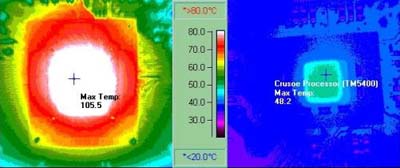Dat is wat ze hier proberen te doen. Ze hebben het over de formules nodig om de temperaturen te berekenen, de methodes die het beste werken om je CPU cool te houden en waarom sommige Coppermines af en toe kapot barsten ![]() :
:
The actually picture will not be like the one Transmeta uses to compare their chip with Intel's mobile chip, it will be the 2 combined, the Crusoe chip being the L2 Cache and the Core being the Intel's mobil chip.
Under such high temperature difference within the die and EPOXY, I expect the thermal stress is much worse a problem than thermal electrons. This might explain why there are quite a few cases of cracked CPU and Intel would take it back without hesitation.
Also, I think that Intel indeed has made a big mistake with the CuMine. In the Celeron design, they also had an EPOXY layer inside (see my page on de-casing the CPU), but the end customers do not have to worry about the contact, because Intel put a nice Silver paste deposite between the EPOXY and the copper cover. But this time, Intel wants to save something, and let the EPOXY directly exposed to the heatsink, so if the customer can not mount the heatsink evenly then one has hot hot spots on the CPU not well cooled.

